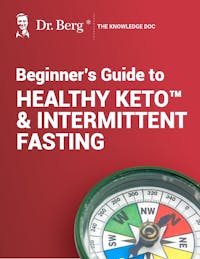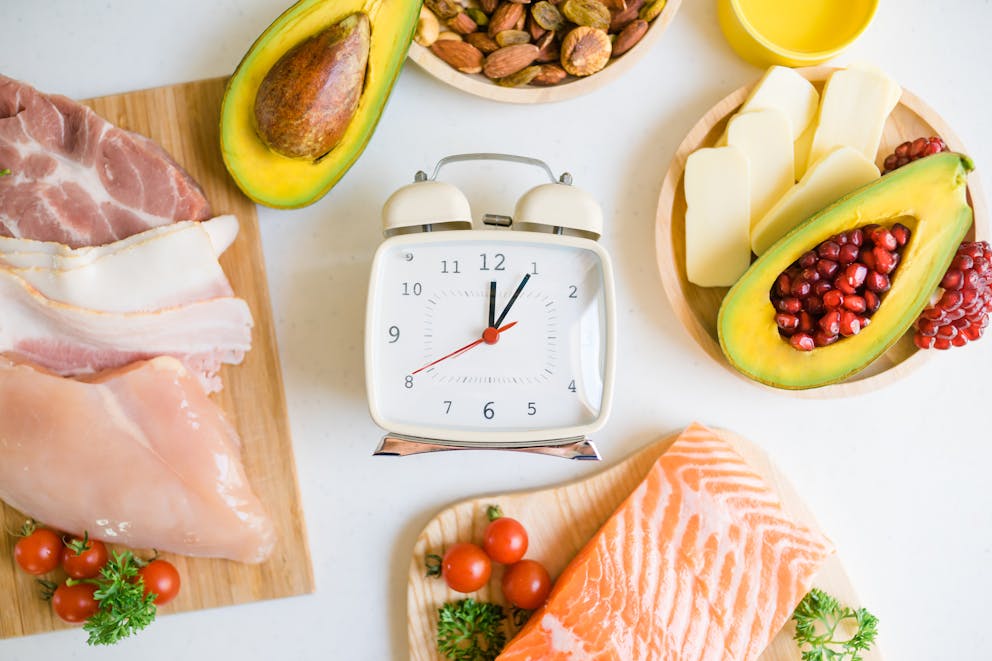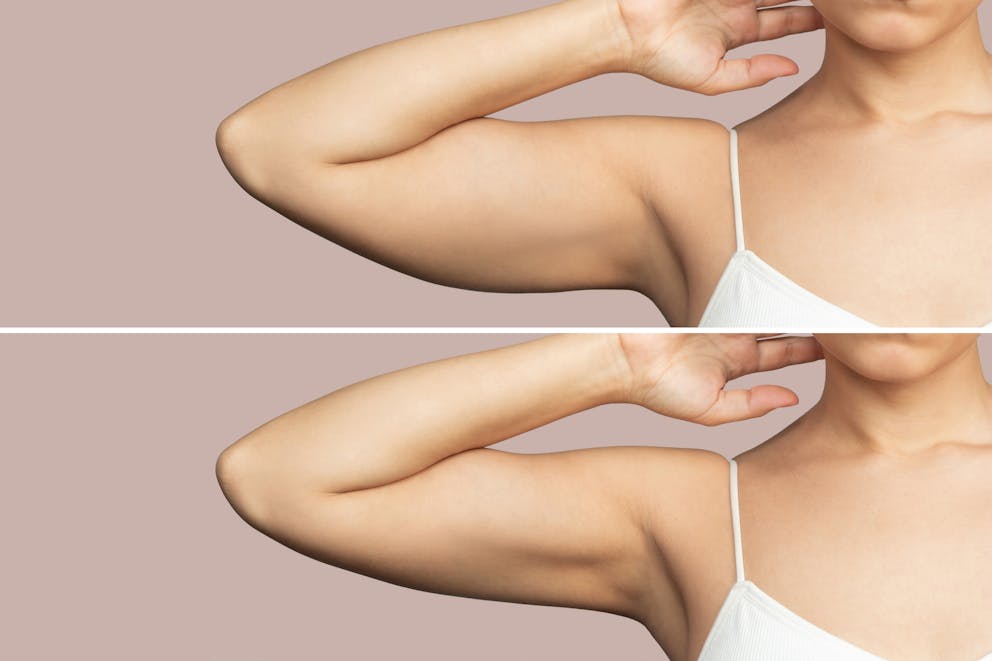Why Are My Upper Arms So Fat? Get Rid of Bat Wings

Beginner’s Guide to Healthy Keto & Intermittent Fasting
Receive a step-by-step guide to starting Healthy Keto® and intermittent fasting
Learn about foundational principles and best practices for beginners
Get detailed visual guidance on portion sizes and meal composition
Discover how to set achievable goals and monitor your progress
Find practical tips for overcoming common challenges and staying motivated

Beginner’s Guide to Healthy Keto & Intermittent Fasting
Receive a step-by-step guide to starting Healthy Keto® and intermittent fasting
Learn about foundational principles and best practices for beginners
Get detailed visual guidance on portion sizes and meal composition
Discover how to set achievable goals and monitor your progress
Find practical tips for overcoming common challenges and staying motivated

Beginner’s Guide to Healthy Keto & Intermittent Fasting
Receive a step-by-step guide to starting Healthy Keto® and intermittent fasting
Learn about foundational principles and best practices for beginners
Get detailed visual guidance on portion sizes and meal composition
Discover how to set achievable goals and monitor your progress
Find practical tips for overcoming common challenges and staying motivated

Beginner’s Guide to Healthy Keto & Intermittent Fasting
Receive a step-by-step guide to starting Healthy Keto® and intermittent fasting
Learn about foundational principles and best practices for beginners
Get detailed visual guidance on portion sizes and meal composition
Discover how to set achievable goals and monitor your progress
Find practical tips for overcoming common challenges and staying motivated

Beginner’s Guide to Healthy Keto & Intermittent Fasting
Receive a step-by-step guide to starting Healthy Keto® and intermittent fasting
Learn about foundational principles and best practices for beginners
Get detailed visual guidance on portion sizes and meal composition
Discover how to set achievable goals and monitor your progress
Find practical tips for overcoming common challenges and staying motivated

Beginner’s Guide to Healthy Keto & Intermittent Fasting
Receive a step-by-step guide to starting Healthy Keto® and intermittent fasting
Learn about foundational principles and best practices for beginners
Get detailed visual guidance on portion sizes and meal composition
Discover how to set achievable goals and monitor your progress
Find practical tips for overcoming common challenges and staying motivated

Beginner’s Guide to Healthy Keto & Intermittent Fasting
Receive a step-by-step guide to starting Healthy Keto® and intermittent fasting
Learn about foundational principles and best practices for beginners
Get detailed visual guidance on portion sizes and meal composition
Discover how to set achievable goals and monitor your progress
Find practical tips for overcoming common challenges and staying motivated

Beginner’s Guide to Healthy Keto & Intermittent Fasting
Receive a step-by-step guide to starting Healthy Keto® and intermittent fasting
Learn about foundational principles and best practices for beginners
Get detailed visual guidance on portion sizes and meal composition
Discover how to set achievable goals and monitor your progress
Find practical tips for overcoming common challenges and staying motivated

Beginner’s Guide to Healthy Keto & Intermittent Fasting
Receive a step-by-step guide to starting Healthy Keto® and intermittent fasting
Learn about foundational principles and best practices for beginners
Get detailed visual guidance on portion sizes and meal composition
Discover how to set achievable goals and monitor your progress
Find practical tips for overcoming common challenges and staying motivated

Beginner’s Guide to Healthy Keto & Intermittent Fasting
Receive a step-by-step guide to starting Healthy Keto® and intermittent fasting
Learn about foundational principles and best practices for beginners
Get detailed visual guidance on portion sizes and meal composition
Discover how to set achievable goals and monitor your progress
Find practical tips for overcoming common challenges and staying motivated

Beginner’s Guide to Healthy Keto & Intermittent Fasting
Receive a step-by-step guide to starting Healthy Keto® and intermittent fasting
Learn about foundational principles and best practices for beginners
Get detailed visual guidance on portion sizes and meal composition
Discover how to set achievable goals and monitor your progress
Find practical tips for overcoming common challenges and staying motivated

Beginner’s Guide to Healthy Keto & Intermittent Fasting
Receive a step-by-step guide to starting Healthy Keto® and intermittent fasting
Learn about foundational principles and best practices for beginners
Get detailed visual guidance on portion sizes and meal composition
Discover how to set achievable goals and monitor your progress
Find practical tips for overcoming common challenges and staying motivated

Beginner’s Guide to Healthy Keto & Intermittent Fasting
Receive a step-by-step guide to starting Healthy Keto® and intermittent fasting
Learn about foundational principles and best practices for beginners
Get detailed visual guidance on portion sizes and meal composition
Discover how to set achievable goals and monitor your progress
Find practical tips for overcoming common challenges and staying motivated

Beginner’s Guide to Healthy Keto & Intermittent Fasting
Receive a step-by-step guide to starting Healthy Keto® and intermittent fasting
Learn about foundational principles and best practices for beginners
Get detailed visual guidance on portion sizes and meal composition
Discover how to set achievable goals and monitor your progress
Find practical tips for overcoming common challenges and staying motivated

Beginner’s Guide to Healthy Keto & Intermittent Fasting
Receive a step-by-step guide to starting Healthy Keto® and intermittent fasting
Learn about foundational principles and best practices for beginners
Get detailed visual guidance on portion sizes and meal composition
Discover how to set achievable goals and monitor your progress
Find practical tips for overcoming common challenges and staying motivated

Beginner’s Guide to Healthy Keto & Intermittent Fasting
Receive a step-by-step guide to starting Healthy Keto® and intermittent fasting
Learn about foundational principles and best practices for beginners
Get detailed visual guidance on portion sizes and meal composition
Discover how to set achievable goals and monitor your progress
Find practical tips for overcoming common challenges and staying motivated
Loose arm fat is more common in women than in men and typically is caused by hormonal changes or imbalances.
Supporting estrogen balance by avoiding foods with estrogenic properties and boosting your body’s growth hormone production with intermittent fasting and high-intensity exercise helps eliminate stubborn fat in the upper arm region.
Let’s take a deeper look at the causes of upper arm fat and what steps you can take to get rid of flabby arms.

What causes upper arm fat?
Flabby arms, also known as bat wings, are excessive accumulations of fat in the upper arm region.
There is a significantly higher prevalence of excess arm fat in women than in men, and it’s thought that hormonal changes, age, and weight fluctuations play a significant role in the development of stubborn upper arm fat.
Age
As you age, the skin loses elasticity, and muscle mass typically decreases, which, combined with excess fat accumulations due to age-related weight gain, can cause sagging and flabby upper arms.
Genetics
Some individuals have a genetic predisposition to have more fat, which increases the likelihood of developing saggy upper arms.
Weight fluctuations
While excess weight can contribute to fat depositions, rapid weight loss can also lead to loose and flabby arm skin.
Hormonal changes
Human growth hormone (HGH), estrogen, and testosterone levels regulate where and how you gain weight, which greatly influences your body composition and metabolic body type.
Factors such as age, stress, dietary factors, and lifestyle habits can trigger hormonal imbalances and may potentially cause the accumulation of fat in your upper arms.
Poor diet
A diet high in processed foods, sugars, carbs, and excessive calorie intake can contribute to weight gain and overall body fat accumulation, including in the upper arms.
Watch the video below to learn how to lose fat in the upper arms fast.
Six ways to get rid of upper arm fat
Without addressing the underlying causes, losing arm fat can be challenging. This may explain why you suffer from persistent arm fat even though you regularly lift weights and incorporate bicep curls and strength training exercises into your workout routine.
“Hormones such as estrogen and human growth hormone influence muscle tone and skin elasticity and determine where your body stores fat, which significantly impacts your body shape,” explains Dr. Berg. “Supporting hormonal balance is one of the most crucial steps to get rid of upper arm fat and achieve overall weight loss.”
Here are six steps that you can take to support hormonal balance and reduce arm fat.
1. Avoid estrogenic foods
Your diet can significantly influence your hormone levels, and it's important to be mindful of certain foods that may have estrogenic properties.
Estrogenic foods either have been treated with hormones or contain natural compounds that can mimic the effect of estrogen in the body and stimulate fat accumulation in the upper arms.
Here are some foods that are considered to have estrogenic properties:
Alfalfa
Non-organic dairy products
Non-organic beef, chicken, and pork
Wheat and grains
Alcohol, especially beer
2. Eat cruciferous vegetables daily
Cruciferous vegetables, such as broccoli, cauliflower, watercress, kale, and cabbage, contain phytochemicals, including glucosinolates.
When these vegetables are chewed or chopped, glucosinolates are broken down into various bioactive compounds, including indole-3-carbinol (I3C) and sulforaphane.
I3C and sulforaphane promote estrogen metabolism and help convert estradiol, the most potent form of estrogen, into a less active form that helps maintain estrogen balance.

3. Intermittent fasting
Intermittent fasting (IF) is a mealtime schedule that cycles between fasting and time-restricted eating periods. Fasting has beneficial effects on metabolic health and profoundly influences hormonal balance.
Fasting raises growth hormone levels, which support healthy muscle tone and skin elasticity, and stimulates the breakdown of stored fat which helps to reduce fat in the upper arms.
In fact, a study published in Endocrine Metabolism found that short-term fasting can raise HGH concentrations by 400 percent and that fasting for 48 hours can increase HGH by as much as 1000 percent.
4. Exercise in short bursts
Research published in Physiological Reports found that short bursts of high-intensity interval training (HIIT) significantly increase human growth hormone levels.
In addition, HIIT burns fat and improves muscle mass, which reduces overall body fat and can help to get rid of flabby arm fat.
5. Manage stress
During stress, your adrenal glands release cortisol, a hormone that regulates the body's natural stress response.
However, chronic stress can lead to persistently elevated cortisol levels, which interfere with estrogen production and disrupt the delicate balance between estrogen and progesterone linked to fat accumulations in the upper arms.
If you often feel tense and stressed, learning how to relax helps to promote hormonal balance, improves sleep, and can increase your overall well-being.
6. Get enough sleep
Sufficient sleep is essential for hormone regulation, including estrogen balance. Avoid sedative sleep aids, establish a good sleep routine, and limit stimulants such as caffeine and alcohol, which are common reasons for poor sleep.
And what’s more, sleep quality and duration influence HGH secretion. Deep, uninterrupted sleep is associated with optimal growth hormone release, and sleep disorders, including sleep apnea or insomnia, disrupt normal sleep cycles and negatively impact HGH production.
Watch the video below to learn how to naturally boost human growth hormone production.
Why is arm fat more common in women than men?
Hormones play a significant role in fat distribution.
Estrogen, the predominant female sex hormone, stimulates fat accumulation in the subcutaneous layer under the skin rather than the visceral layer around the organs. This explains why men tend to have more belly fat and women are more likely to develop arm fat.
As women age and go through menopause, ovaries gradually decrease the production of estrogen and other reproductive hormones, including progesterone.
An imbalanced estrogen-to-progesterone ratio, known as estrogen dominance, is typically the main culprit of age-related weight gain and upper arm fat.
Compared to men, women have different body compositions. Women tend to have a higher percentage of subcutaneous fat that sits beneath the skin and, at the same time, have less upper arm muscle mass, which can cause a fat buildup in the upper arm region.

Key takeaways
Flabby upper arms are more common in women than in men. They’re often a result of age-related hormonal changes that lead to loss of muscle mass and reduced skin elasticity.
Supporting balanced levels of estrogen and boosting growth hormone production promotes the breakdown of fat, supports skin integrity, and maintains muscle mass, all of which help to reduce fat in the upper arms.
Practicing intermittent fasting, avoiding foods with estrogenic properties, getting enough sleep, managing stress, and regularly incorporating HIIT exercises into your workout regimen supports hormonal balance and can prevent or even reverse upper arm fat.
By taking a personalized test to determine your body type, you can gain valuable insights into your individual physiological traits, metabolism, and potential health issues. This understanding allows you to make informed decisions about your diet, exercise, and lifestyle, leading to improved overall well-being and more effective progress toward your health goals.
FAQ
1. Why are my upper arms flabby?
Fat upper arms are typically caused by a combination of imbalanced hormone levels, aging, and weight fluctuations.
Human growth hormone (HGH) and estrogen regulate muscle mass and skin elasticity and determine where the body stores fat. Imbalanced hormone levels can lead to reduced muscle tone and loss of skin integrity and stimulate fat deposition in the subcutaneous fat layer beneath the skin, which causes flabby arms.
2. What causes upper arm fat in females?
An imbalanced ratio of the female sex hormones progesterone and estrogen, also known as estrogen dominance, can cause fat gain in the subcutaneous fat layer beneath the skin and is typically the main reason for upper arm fat in women.
3. How do you lose arm fat?
Addressing underlying causes, including low levels of HGH and potential estrogen dominance, is crucial to reduce fat in the upper arms.
Avoiding estrogenic foods such as soy products and non-organic dairy supports balanced estrogen levels, and practicing intermittent fasting and regularly incorporating high-intensity interval training into your workout routine boosts HGH and can prevent and even reverse flabby upper arms.
4. Why are my upper arms fatter than the rest of my body?
The distribution of body fat can vary among individuals, and it's not uncommon to have a higher concentration of fat in the upper arms compared to other parts of the body.
Factors such as age, thin upper arm skin, hormonal influences, weight gain, or rapid weight loss can lead to saggy upper arms.
5. Are arms with excess fat more common in women?
Yes, upper arm fat is more prevalent in women than men. Women typically have less muscle mass and a higher percentage of subcutaneous fat located just beneath the skin, associated with flabby upper arms.
In addition, as women age, estrogen levels change which can trigger more fat being stored in upper body regions such as breast tissue and the upper arms.
6. What are bat wings?
The term bat wings is typically used to describe sagging skin and excess fat around the upper arm region, which is more noticeable when the arms are in motion, extended, or lifted.
Previous blog
The Best Tip for Lazy ProcrastinatorsNext blog
The Best Liver Cleansing FoodsTags

Popular
08/21/2024
55.7K views
02/23/2025
46.8K views
11/18/2024
281K views
03/18/2024
11/21/2022




